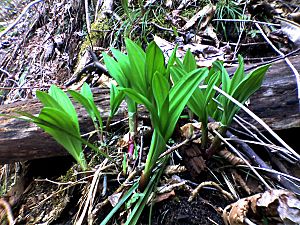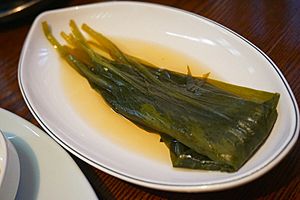Siberian onion facts for kids
Quick facts for kids Allium ochotense |
|
|---|---|
 |
|
| Allium ochotense | |
| Scientific classification |
Allium ochotense, also known as the Siberian onion, is a type of wild onion. It grows naturally in East Asia, including northern Japan, Korea, China, and the Russian Far East. You can also find it on Attu Island in Alaska.
Some experts used to think A. ochotense was the same as another plant called A. victorialis. However, most scientists now agree that it is its own unique species.
Contents
What Does Siberian Onion Look Like?
Siberian onion plants usually grow to be about 20 to 30 centimeters (8 to 12 inches) tall. They have a very strong smell, a lot like garlic.
The plant has bulbs that are covered in a grayish-brown, net-like layer. Its leaves are wide and smooth, and its flowers are a whitish-green color. This plant grows slowly. Besides growing from seeds, it can also spread using two other methods. One way is by growing new shoots from its base, and the other is through special buds that grow in unusual places.
The smell of Siberian onion is very strong, even more intense than regular garlic. This is because of certain chemicals inside the plant.
Where Does the Name Come From?
The first part of the name, Allium, is an old Latin word for garlic.
The second part, ochotense, was given by a Soviet scientist named Yarosláv Ivánovich Prokhánov. He likely named it after the Okhotsk region in Russia. This is an area where the Siberian onion is known to grow.
Where Can You Find Siberian Onion?
Siberian onion is mostly found around the Amur River basin. This includes parts of Siberia in the Russian Far East, like the Amur, Khabarovsk, and Primorye regions. It also grows on Sakhalin and the Kuril Islands.
In China, you can find it in many provinces, including Inner Mongolia, Heilongjiang, Jilin, and Liaoning. It also grows in Korea, especially on Ulleung Island and in high mountains (over 1,000 meters or 3,280 feet), such as Paektu Mountain.
In Japan, it grows from Hokkaido down to the Kinki area. It prefers wet, forested areas in subalpine regions. The plant also grows in the United States, but only naturally on Attu Island. This island is the westernmost part of the Aleutian Islands. Some plants are found on Unalaska Island, but these were likely brought there by people.
How is Siberian Onion Grown?
Since around 1990, people in Hokkaido and snowy parts of eastern Honshū in Japan have started growing Siberian onion on farms. It takes about four years for the plant to be ready to harvest after its seeds are planted.
New Types of Siberian Onion
At Utsunomiya University in Japan, researchers created a new hybrid plant. They crossed Siberian onion (A. ochotense) with garlic chives (A. tuberosum). They named this new plant gyōjana. It looks like garlic chives but has thicker stems, like A. victorialis. Unlike Siberian onion, gyōjana can be harvested after just one year. It has been sold in stores since 2008.
How is Siberian Onion Used?
Cooking with Siberian Onion
In China
In China, Siberian onion is called gecong or shancong. It might not be used everywhere. One group of people, the Jiarongic minority, gather its tender young leaves. They dry them in the sun and serve them on special occasions.
In Japan
The Japanese name for Siberian onion is gyōja ninniku. This means "garlic used by a gyōja." A gyōja is a monk or someone who does special outdoor training.
Many places where Siberian onion grows are nature reserves, like national parks. This makes it a rare wild vegetable, called sansai. Because it's rare, it can be quite expensive in markets.
The Ainu people, who are native to Japan, have traditionally used Siberian onion as an important food. In their language, it's called pukusa, kitobiru, or simply kito. In Hokkaido, Siberian onion is ready to be gathered in early to mid-May. The Ainu usually collect the leaves, not the whole bulb. They chop and dry the leaves to use later. The Ainu might use the plant in a savory soup called ohaw, or in a stew-like dish called ratashkep.
Today, people often preserve the leafstalks by soaking them in soy sauce. Fresh leaves can be lightly boiled and served plain, or with a special Japanese broth called dashi. They are also used in gyōza (dumplings) or mixed into a tamagoyaki-style omelet. Young, unopened leaves with a stalk about 1 centimeter (half an inch) long are especially valued for their rich flavor and smell. Also, stalks grown commercially by a process called blanching (like white asparagus) are becoming popular.
It's important to be careful when gathering Siberian onion in Japan. Some poisonous plants look similar, such as Veratrum album, Veratrum stamineum, Colchicum autumnale, and lily of the valley. The strong, distinct smell of Siberian onion helps tell it apart from these dangerous plants.
In Korea

In Korea, A. ochotense and A. microdictyon are both called sanmaneul, which means "mountain garlic." The official name for A. ochotense is Ulleung sanmaneul, meaning "Ulleung Island mountain garlic." However, most Korean people call it myeongi. It is also known as myeonginamul because it is considered a namul (a type of vegetable side dish).
Myeongi is a special food from Ulleung Island, where its leaves grow wider and stronger.
The leaves and bulbs of myeongi are often eaten as a namul side dish. They can also be used as a ssam vegetable, which means wrapping them around grilled meat like samgyeopsal (grilled pork belly). Myeongi is also often pickled as a jangajji side dish. Sometimes, it's added as the last ingredient to dak-gomtang (chicken bone soup).
In Siberia
In Siberia, people eat the young shoots of the Siberian onion.
Medicinal Uses
In Japan
In Japan, the Ainu people have used pukusa, or Siberian onion, as a traditional folk medicine.
In Korea
In traditional Korean medicine, myeongi was thought to be a "warming" herb. It was used to help with indigestion and heartburn. It was also believed to help with small abscesses and to detoxify after bites and stings from venomous insects.
Magical Beliefs
In Japan, Ainu stories say that Siberian onion could keep diseases away because of its strong smell. If an epidemic happened, people would hang the onion at the entrances to their villages or from the roofs of their houses.
Images for kids
-
A. ochotense (Nagano prefecture)



